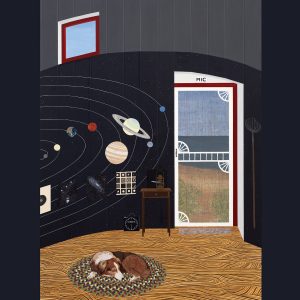
Mary Lattimore is well-known for her collaborative works, including recently-acclaimed albums with artists such as Meg Blair and Mac McCaughan. She’s also released two solo albums of contemplative and solemn harp music, the last one being 2018’s stunning Hundreds of Days. This year alone Lattimore has also contributed to Soccer Mommy’s Color Theory and Julianna Barwick’s Healing Is a Miracle, and this week she has two records out on the same day, with Silver Ladders released alongside Roped In, the highly-anticipated record from North Americans on which she also appears.
In a way, her third album is both a solo effort and another collaborative record. It was produced by Neil Halstead, of the iconic British shoegaze band Slowdive, marking them arguably as an unexpected pairing. Lattimore is often used to producing herself but Halstead’s work here leaves an indelible trace. If the harp has always been a rather restrained instrument, his rhythmic additions – bold synths and mesmerising guitar lines – force her playing to expose itself more.
Yet it’s the classically-trained American who still leaves one astounded by her innate understanding of one particular instrument and precision at invoking profound emotion with it. Her harp is lightly played at the start of ‘Pine Trees’. Hushed synths waver behind her. The tone is mild, the air still. Several moments of narrative intrigue follow. As Lattimore tells it, the title track is about a place in Croatia on the island of Hvar. The sea was deep green and blue and she was able to float with all of the people from the town; as she did so, she thought that it was the most beautiful place on earth. It’s why her harp here washes over the listener, soothing waves of tranquility. If one were to admire a watercolour painting, this could be the sonic accompaniment.
Another example arrives on ‘Chop On The Climbout’, inspired by a warning that Lattimore heard whilst travelling on a small aircraft over the Atlantic sea. The strong, droning synths imitate this experience, Lattimore’s caressed harp sounding like the interrupting patter of raindrops on the windows as the craft ascends into the shadows of the clouds. The peace is upended with the following ‘‘Til A Mermaid Drags You Under’. It’s the longest song by far, flowing for almost 11 minutes. Layers of multi-tracked harps submerge the listener, holding their attention. The atmosphere is now ominous, abetted by Halstead’s zooming synths that rise and fall out of coherence.
The pair reworked three existing demos and improvised the other four songs for the album. ‘Sometimes He’s In My Dreams’ was a joint piece with Halstead and it’s when his contribution is at its clearest. His melancholic guitar line intercepts Lattimore’s pulsating harp but his playing is never enervating, only enhancing the sound. It’s a wonderful piece of ambient music, a genre which Slowdive often touched upon in their shoegaze records.
There are darkened hues to the palette. ‘Don’t Look’ was written in response to Lattimore discovering the story of a local beachside tragedy in which four adults died rescuing distressed teenagers. It’s why she plays restrained and considered at the beginning, only to open up her harp with heavier plucks, as if she herself is being subsumed by the dangerous tides.
Although based in Los Angeles, Lattimore recorded Silver Ladders at Halstead’s own studio in Cornwall. Indeed, there’s something quite English about it, a feeling of quaintness and pastorality. The sounds belong to the outside world and nature, the shimmering harp unfurling like a wistful mist over a Cornish moor. After the contrasting tones, the depths of despair and the heights of contentment being explored, ‘Thirty Tulips’ closes the album with a delicate pleasantness.
The current moment is a desperate time for language. Our fake news, post-truth society has rendered words meaningless. It’s comforting, then, to bear witness to Lattimore’s ability to create wordless passages of reflective and ruminative meaning in the absence of lyrical storytelling. Silver Letters is sublime ambient art, a meditative work timed exquisitely for the arrival of autumn.
